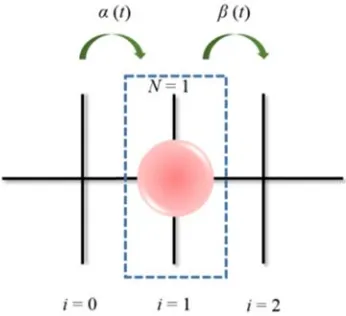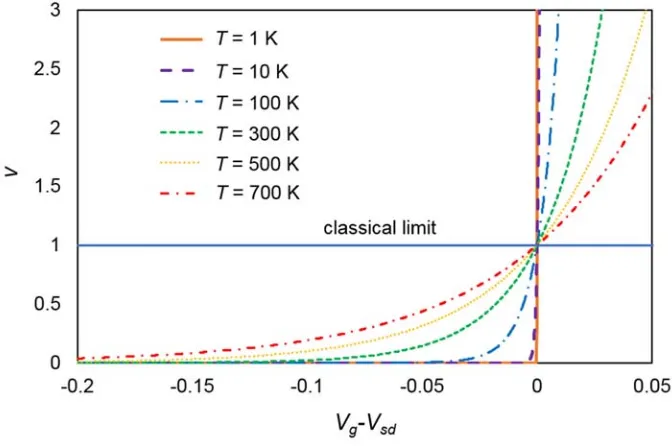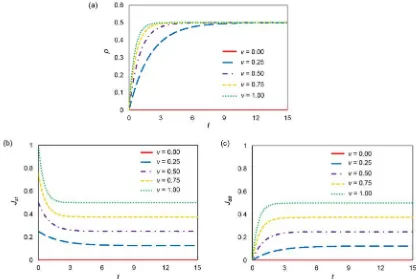PAPER • OPEN ACCESS
On the classical aspects of electrons tunnelling through a quantum dot
via a driven lattice gas model in one dimension
To cite this article: E P F Noviani and W S B Dwandaru 2018 J. Phys.: Conf. Ser.953 012009
View the article online for updates and enhancements.
On the classical aspects of electrons tunnelling through a
quantum dot via a driven lattice gas model in one dimension
E P F Noviani1 and W S B Dwandaru2
1Department of Physics Education, Widya Mandala Catholic University, Surabaya, 60114, Indonesia
2Department of Physics Education, Faculty of Mathematics and Natural Sciences, Universitas Negeri Yogyakarta, Karangmalang Complex, Yogyakarta, 55281, Indoneisa
Abstract. A theoretical study of classical aspects, i.e.: density, current density, and average speed of electrons tunnelling through a quantum dot (QD) via a simple driven lattice gas model have been carried out. The main objective of this study is to determine some classical aspects of electron tunnelling through a QD using the driven lattice gas model. The study is conducted by considering a resemblance between the components of the QD with the components of the totally asymmetric simple exclusion process (TASEP) that consists of only a single site and open boundary conditions. The former consists of a source, an island, and a drain, which corresponds respectively to the left reservoir (i = 0), site i = 1, and the right reservoir (i = 2) of the latter.
Explicit expressions of the density, current densities, and average speed for electrons tunnelling through the QD in the classical regime are obtained. At the steady state, the density of electrons tunnelling through the dot is 0.5 and the current density becomes v/2, where v is the speed of the
electrons. Furthermore, the speed of the electrons may be obtained as functions of temperature and the difference between gate and source-drain potentials. For very low temperatures, the speed of electrons rapidly goes to zero pointing to the occurrence of Coulomb blockade.
1. Introduction
Nowadays, nanomaterial such as quantum dot (QD) have attracted much attention because of their superior electronic, optical, and magnetic properties due to confinement effects [1,2]. A confinement of an electron in all its three spatial coordinates is designated as a QD. A QD is a mesoscopic system which resembles an atom although it is tens or hundreds times bigger than an actual atom, e.g. the Zeeman Effect and discrete energy levels [3], hence entitling the QD as an artificial atom [4]. Another interesting feature is that its physical properties depend on the voltage applied to the dot, whereas an atom depends upon its valence electrons. The QD has been a subject of various applications including optical and optoelectronic devices [5,6], quantum computing [7], DNA testing [8,9], three dimensional (3D) imaging [10], and displays [11,12].
2
are associated to their respective electrochemical potentials, i.e.: source and drain. Both chemical potentials are connected through the source-drain potential, Vsd, that is, eVsd = (source - drain), where e is the electron unit of charge. The Coulomb blockade and SET are realized by differences in values between source, drain, and (N), where the latter is the chemical potential of N electrons inside the island.
Figure 1. The energy diagram of a QD. (A) is the Coulomb blockade and (B) is the SET.
A standard mathematical model which can be utilized to study many physical properties of dynamical systems is the totally asymmetric simple exclusion process (TASEP) in one dimension (1D). This is a simple driven lattice gas model where hard-core particles occupying a discrete lattice sites, i L, may jump to their respective right-nearest neighbour sites, (i + 1) L, provided that the right-nearest neighbour sites are not occupied by any other (hard-core) particle. The jumping of particles is defined by hopping rules, which usually takes the sequential or parallel up-dating dynamics. The TASEP is also equipped with boundary conditions, which may be open or periodic. Furthermore, the model is a renowned particle hopping model [15] which is employed to investigate various transport phenomena, such as protein synthesis [16], motor protein in organism [17], the track of a group of insects [18], and road traffic congestions [19].
Figure 2. The TASEP that consists of only a single site, i.e.: N = 1.
rectangular lines), respectively. A hard-core particle may enter site i = 1 with an input rate of (t) and exit the site with an output rate of (t) [green arrows].
Here, the TASEP which consists of only a single site (Figure 2) is utilized to study the dynamics of electrons tunnelling through the dot in the SET. This may be considered as the simplest arrangement of the model where only one site is used, i.e.: i = N = 1, with N is the total number of sites. The single site is attached to two reservoirs at each end of the site which indicates an open boundary condition. The left (right) reservoir, viz.: i = 0 (i = 2) allows particles to jump to (out of) the system (site i = 1) with input rate (t) [output rate (t)].
We present an application of the TASEP consisting of only a few sites, e.g.: 1 ≤ N ≤ 3 which is rarely investigated other than being used to confirm physical theories, let alone applied to model a physical system. It is necessary to emphasize here that this study offers an alternative approach in investigating classical aspects of the dynamics of a mesoscopic system, i.e. QD, through a simple classical dynamical model. This study brings a new perspective in the relationship between dynamical models providing insights of one model (SET) through the other (TASEP with a single site), or vice versa. In this case, the main focus is to obtain explicit expressions for the average speed, density, and current densities of electrons tunnelling through the dot using the TASEP consisting of only a single site. This study enriches the many methods in describing the dynamics of electrons inside QD, which is worth scientific exploration and have not been reported before.
2. The Relationship
We may observe a physical resemblance of the TASEP with a single site and the two mechanisms in QD (Table 1). The system (site i = 1) of the TASEP represents the dot (island), the reservoirs of the TASEP at site i = 0 and i = 2 represent the source and drain, respectively.
Table 1. A connection between the components of the TASEP with a single site and QD.
No. TASEP with a single site connection QD
1. 0 source potential between particles. This potential is obtained via a purely infinite repulsive potential between the centres of two particles until a certain inter-atomic distance. Beyond this distance, the particles are non-interacting. Hence, no other particle may occupy site i = 1 if the site is occupied by a particle. However, the nature of the Coulomb blockade and SET is completely different from that of the hard-core potential. In the QD, the movement or confinement of an electron is caused by chemical potential differences between the source, island, and drain, through the applied voltages. However, the two models look similar in the sense that there is only a single particle (electron) that may enter or exit the site (dot). Hence, the confinement (tunnelling) of a single electron in the dot is somewhat similar to a classical particle occupying (jumping out of) the lattice sites in the TASEP. Therefore, a connection can be constructed between TASEP, Coulomb blockade, and SET.
4
into and out of the dot. The results are static densities of the monomer and dimer in terms of the applied voltages of the QD. A physical understanding of these densities may be acquired by connecting them to the TASEP with a single site in the second stage of the relationship. At this point, the monomer is associated to the particle occupying site i = 1 and the dimer is associated to the particle going into or out of site i = 1 of the TASEP. The densities of the monomer and dimer can then be associated to the density and current density of the TASEP, respectively [21]. Hence, giving the final results of the density of an electron confined in the dot and the current density of the electron tunnelling through the dot (Table 1).
3. Density, Current Density, and Average Speed of Electrons Tunnelling through a QD
Following the above connection, we may obtain a continuity equation, i.e. [22]:
, 1
where (t) is the density of an electron in the dot at time t which gives the average occupancy of electrons in the dot,
exp
B g sd 1 , 2
is the current density of the electron entering the dot from the source, s(t) is the density of electrons in the source at time t,
exp 1 , 3
is the current density of the electron exiting the dot to the drain, and d(t) is the density of electrons in the drain at time t. It may be observed that the current densities of the electron depend upon Vg and Vsd. Furthermore, by setting the input and output rates as
exp , 4
and
exp 1 , 5
respectively, we may modify equations (2) and (3) to become
1 , 6
and
respectively. Equations (6) and (7) give a simpler form of the current densities of electrons that depend explicitly only on the density of electrons in the dot and the input and output rates. Here, the dependency of the current densities upon time, t, is through the density and the input and output rates. In order that the current density of electrons only depends upon the applied voltages, we may set s(t) = 1.0 and d(t) = 0.0. This indicates that at any time t, the source will always be filled with electrons and the drain will always be empty. Thus we may obtain the average speed of electrons tunnelling through the dot as
exp
B g sd , 8
which is time-independent and depends upon the temperature and the difference between the applied potentials. Hence, equations (6) and (7) becomes
st 1 , 9
and
dd , 10
where now the time dependency of the current densities only comes from the density of the electron in the dot. Equations (1), (9), and (10) determine the evolution of the density of electrons in the dot. This indicates that the density of electrons at any time may be obtained via the current densities by formally solving equation (1).This may be attained by inserting equations (9) and (10) into equation (1), giving:
1 1 2
or
d
1 2 d .
Solving the LHS of the above integral via a substitution method produces an explicit expression for the density as a function of time, viz.:
1
2 1 . (11)
6
st 2 1 , (12)
and
dd 2 1 . (13)
Equations (11), (12), and (13) are a set of explicit equations that describe the dynamics of the electrons moving through the dot.
Figure 3. The average speed of electrons as functions of the applied potential differences, Vg – Vsd, at various temperatures, T.
However, as v, the current densities tend to infinite as well (Jst, Jdd), but the density remains finite ( = 0.5).
For some long evolution time, i.e. t , Equations (11) – (13) may achieve a steady state condition where the density does not depend again upon time, i.e.: = 0.5, and Jst = Jdd = v/2 does not vanish, as shown in Figure 4. This implies that at steady state the dot (island) has half a chance in average of being occupied by an electron or being empty. This is of course in accordance with the SET where electrons may alternately enter and exit the dot through the source and drain, respectively. Hence, the SET may be thought of being in a non-equilibrium steady state (NESS) condition with a non-vanishing current of v/2. It may also be observed in Figure 4(a) that increasing the speed of the electrons tunnelling through the dot causes the system to reach NESS faster.
Figure 4. (a) The density of electron in the dot, , (b) the current density of the electron entering the dot from the source, Jst, and (c) the current density of the electron exiting the dot to the drain, Jdd, as functions of time for various speeds, v.
4. Conclusion
Explicit classical expressions of the density, current densities, and the average speed of electrons tunnelling through a QD are obtained. This may be realized using a relationship between the TASEP with a single site and the QD through the hard-core lattice gas model. The density and current densities of electrons are obtained via the density and current density of the hard-core particles of the TASEP with a single site. In steady state, the Coulomb blockade is obtained when the average speed of the electrons is zero, i.e. for low temperatures, such that = Jst = Jdd = 0. SET is an NESS which is attained for = 0.5 and Jst = Jdd = v/2, respectively.
5. Acknowledgement
8
6. References
[1] Dosch H 2001 Applied Surface Science182 192 – 95 doi: 10.1016/S0169-4332(01)00426-3 [2] Chamarro M, Gourdon C, Lavallard P, Lublinskaya O and Ekimov A I 1996 Phys. Rev. B53
1336 - 42 doi: 10.1103/PhysRevB.53.1336
[3] Dias A C, Fu J, Villegas-Lelovsky L and Qu F 2016 Phys: Condens. Matter28 375803 DOI: 10.1088/0953-8984/28/37/375803
[4] Alivisatos A P 1996 Science271 933-37 doi: 10.1126/science.271.5251.933
[5] Song J, Li J, Li X, Xu L, Dong Y and Zeng H 2015 Adv. Mater 27 7162-67 doi: 10.1002/adma.201502567
[6] Sugawara M, Hatori N, Ishida M, Ebe H, Arakawa Y, Akiyama T, Otsubo K, Yamamoto T and Nakata Y 2005 Phys. D: Appl. Phys.38 2126-34 doi: 10.1088/0022-3727/38/13/008
[7] Loss D and Di Vincenzo D P 1998 Phys. Rev. A57 120-6 doi: 10.1103/PhysRevA.57.120 [8] Goldman E R, Clapp A R, Anderson G P, Uyeda H T, Mauro J M, Medintz I L and Mattousi H
2004 Anal. Chem. 76 684-88 doi: 10.1021/ac035083r
[9] Medintz I L, Uyeda H T, Goldman E R and Mattousi H 2005 Nature Materials 4 435-46 doi: 10.1038/nmat1390.
[10] Michalet X, Pinaud F F, Bentolila L A, Tsay J M, Doose S, Li J J, Sundaresan G, Wu A M, Ghambir S S and Weiss S 2005 Science 307 538-44 doi: 10.1126/science.1104274
[11] Jang E 2010 Adv. Mater.22 3076-80 doi: 10.1002/adma.201000525
[12] Altintas Y, Genc S, Talpur M Y and Mutlugun E 2016 Nanotechnology 27 295604 doi: 10.1088/0957-4484/27/29/295604
[13] Alfarisa S, Dwandaru W S B and Darmawan D 2016 Makara J. Sci. 20 28-32 doi: 10.7454/mss.v20il.5658.
[14] Grabert H and Devoret M H 1992 Single Charge Tunneling-Coulomb Blockade Phenomena in Nanostructures NATO Advanced Study Institute Series B: Physics (New York: Plenum
[17] Chowdhury D, Schadschneider A and Nishinari K 2005 Physics of Life Reviews2 318-52 doi: 10.1016/j.plrev.2005.09.001
[18] Chowdhury D et al. 2007 Traffic Phenomena in Biology: from Molecular Motors to Organisms In: Schadschneider A, Poschel T, Kuhne R, Schreckenberg M, Wolf D E (eds) Traffic and Granular Flow ’05 (Berlin: Springer)
[19] Helbing D 2001 Rev. Mod. Phys.73 1067 doi: 10.1103/RevModPhys.73.1067
[20] Laufente L and Cuesta J A 2002 J. Phys.: Condens. Matter 14 12079-97 doi: 10.1088/0953-8984/14/46/314
[21] Dwandaru W S B and Schmidt M 2007 J. Phys. A: Math. Theor. 40 13209-15 doi: 10.1088/1751-8113/40/44/002



